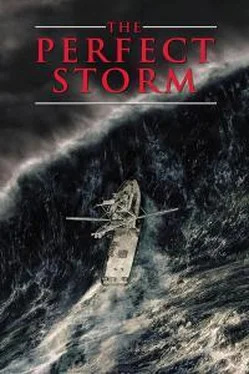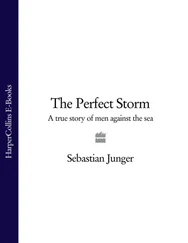Sebastian Junger - The Perfect Storm
Здесь есть возможность читать онлайн «Sebastian Junger - The Perfect Storm» — ознакомительный отрывок электронной книги совершенно бесплатно, а после прочтения отрывка купить полную версию. В некоторых случаях можно слушать аудио, скачать через торрент в формате fb2 и присутствует краткое содержание. Жанр: Триллер, Проза. Описание произведения, (предисловие) а так же отзывы посетителей доступны на портале библиотеки ЛибКат.
- Название:The Perfect Storm
- Автор:
- Жанр:
- Год:неизвестен
- ISBN:нет данных
- Рейтинг книги:3 / 5. Голосов: 1
-
Избранное:Добавить в избранное
- Отзывы:
-
Ваша оценка:
- 60
- 1
- 2
- 3
- 4
- 5
The Perfect Storm: краткое содержание, описание и аннотация
Предлагаем к чтению аннотацию, описание, краткое содержание или предисловие (зависит от того, что написал сам автор книги «The Perfect Storm»). Если вы не нашли необходимую информацию о книге — напишите в комментариях, мы постараемся отыскать её.
The Perfect Storm — читать онлайн ознакомительный отрывок
Ниже представлен текст книги, разбитый по страницам. Система сохранения места последней прочитанной страницы, позволяет с удобством читать онлайн бесплатно книгу «The Perfect Storm», без необходимости каждый раз заново искать на чём Вы остановились. Поставьте закладку, и сможете в любой момент перейти на страницу, на которой закончили чтение.
Интервал:
Закладка:
Having determined his Great Circle route and plugged the heading into the autopilot,
Tyne then goes over to the chart drawer and pulls out a ten-dollar nautical chart called iNt 109. He lines up a course of 250 degrees to his waypoint on the Tail and then walks his way down the map with a set of hinged parallel rules. He rechecks the bearing at the compass rose at the bottom and then adjusts by twenty degrees for the local magnetic variation. (The earth's magnetic field doesn't line up exactly with the axis of the earth; in fact it doesn't even come close.) That should bring him to his waypoint on the Tail in about three days. From there he'll come up fourteen degrees and take another Great Circle route into Gloucester.
INT 109 is one of the few charts that shows the full width and breadth of the summer swordfishing grounds, and is carried by every sword boat in the Banks. It has a scale of one to three-and-a-half-million; on a diagonal it stretches from New Jersey almost to Greenland. Land on 109 is depicted the way mariners must see it, a blank, featureless expanse with a scattering of towns along a minutely rendered coast. The lighthouses are marked by fat exclamation points and jut from every godforsaken headland between New York City and South Wolf Island, Labrador. Water depth is given in meters and shallow areas are shaded in blue. Georges Bank is clearly visible off Cape Cod, an irregular shape about the size of Long Island and rising to a depth of nine feet. To the west of Georges is the Great South Channel; beyond are the Nantucket Shoals and an area peppered with old ordnance: Submerged torpedo, Unexploded depth charges,
Unexploded bombs.
The Two Hundred Fathom line is the chart's most prominent feature, echoing the coastline in broad strokes like a low-angle shadow. It swings north around Georges, skirts Nova Scotia a hundred miles offshore, and then runs deep up the St. Lawrence Seaway. East of the Seaway are the old fishing grounds of Burgeo and St. Pierre Banks, and then the line makes an enormous seaward loop to the southeast. The Grand Banks.
The Banks are a broad flat plateau that extend hundreds of miles southeast from Newfoundland before plunging off the continental shelf. A clump of terrors known as the Virgin Rocks lurk seventy miles east of St. Johns, but otherwise there are no true shoals to speak of. A sheet of cold water called the Labrador Current flows over the northern edge of the Banks, injecting the local food chain with plankton; and a sluggish warm-water flow called the North Atlantic Current creeps toward Europe east of the Flemish Cap. Bending around the Tail of the Banks is something called Slope Water, a cold halfknot current that feeds into the generally eastward movement of the area. Below Slope Water is the Gulf Stream, trundling across the Atlantic at speeds of up to three or four knots. Eddies sometimes detach themselves from the Gulf Stream and spin off into the North Atlantic, dragging entire ecosystems with them. These eddies are called warm core rings. When the cores fall apart, the ecosystems die.
Billy wants to run a slot between the Gulf Stream to the south and Sable Island to the north. It's a relatively straight shot that doesn't buck the warm headcurrent or come too close in to Sable. Steaming around the clock, he's looking at a one-week trip; maybe he even takes one bird out of the water to speed things up. The diesel engine has been throbbing relentlessly for a month now and, without the distraction of work, it suddenly seems hellishly loud. There's no way to escape the noise—it gets inside your skull, shakes your stomach lining, makes your ears ring. If the crew weren't so sleep-deprived it might even bother them; as it is they just wallow in their bunks and stand watch at the helm twice a day. After two-and-a-half days the Andrea Gail has covered about 450 miles, right to the edge of the continental shelf. The weather is fair and there's a good rolling swell from the northeast. At 3:15 on the afternoon of October 27th, Billy Tyne raises the Canadian Coast Guard on his single sideband to tell them he's entering Canadian waters. This is the American fishing vessel Andrea Gail, WYC 6681, he says. We're at 44.25 north, 49.05 west, bound for New England. All our fishing gear is stowed.
The Canadian Coast Guard at St. Johns gives him the go-ahead to proceed. Most of the sword fleet is a couple of hundred miles to the east, and Albert Johnston is the same distance to the south. Sable Island is no longer in the way, so Billy comes up fourteen degrees and puts Gloucester right in his gunsights. They're heading almost due west and running a Great Circle route on autopilot. Around nightfall a Canadian weather map creaks out of the satellite fax. There's a hurricane off Bermuda, a cold front coming down off the Canadian Shield, and a storm brewing over the Great Lakes. They're all heading for the Grand Banks. A few minutes after the fax, Linda Greenlaw calls.
Billy, you seen the chart? she asks.
Yeah I saw it, he says.
What do you think?
Looks like it's gonna be wicked.
They agree to talk the next day so Billy can give her a list of supplies he's going to need. He has no desire at all to talk to Bob Brown. They sign off, and then Billy hands the helm off to Murph and goes below for dinner. They're in a big steel boat with 40,000 pounds of fish in the hold, plus ice. It takes a lot to sink a boat like that. Around nine o'clock, a halfmoon emerges off their port quarter. The air is calm, the sky is full of stars. Two thousand miles away, weather systems are starting to collide.
THE BARREL OF THE GUN
The men could only look at each other through the falling snow, from land to sea, from sea to land, and realize how unimportant they all were.
—SHIP ON THE ROCKS, NEWBURYPORT, MASSACHUSETTS, 1839, NO SURVIVORS.
(SIDNEY PERLEY, Historic Storms of New England, 1891)
THERE'S a certain amount of denial in swordfishing. The boats claw through a lot of bad weather, and the crews generally just batten down the hatches, turn on the VCR, and put their faith in the tensile strength of steel. Still, every man on a sword boat knows there are waves out there that can crack them open like a coconut. Oceanographers have calculated that the maximum theoretical height for wind-driven waves is 198 feet; a wave that size could put down a lot of oil tankers, not to mention a seventy-two-foot sword boat.
Once you're in the denial business, though, it's hard to know when to stop. Captains routinely overload their boats, ignore storm warnings, stow their life rafts in the wheelhouse, and disarm their emergency radio beacons. Coast Guard inspectors say that going down at sea is so unthinkable to many owner-captains that they don't even take basic precautions. "We don't need an EPIRB because we don't plan on sinking,” is a sentence that Coast Guard inspectors hear a lot. One of the videos on file with the Portland Coast Guard—shown as often as possible to local fishermen—was shot from the wheelhouse of a commercial boat during a really bad blow. It shows the bow rising and falling, rising and falling over mammoth, white-streaked seas. At one point the captain says, a little smugly, "Yep, this is where you wanna be, right in your wheelhouse, your own little domain—."
At that moment a wall of water the size of a house fills the screen. It's no bigger than the rest of the waves but it's solid and foaming and absolutely vertical. It engulfs the bow, the foredeck, the wheelhouse, and then blows all the windows out. The last thing the camera sees is whitewater coming at it like a big wet fist.
The farther you work from shore, the less smug you can afford to be. Any weekend boater knows the Coast Guard will pluck him out of whatever idiocy he gets himself into, but sword boats don't have that option. They're working four or five hundred miles from shore, way beyond helicopter range. So Billy—any bluewater fisherman—has a tremendous respect for the big wet fist. When Billy receives the weather chart off the fax machine, he undoubtedly tells the crew that there's something very heavy on the way. There are specific things you can do to survive a storm at sea and whether the crew does them, and how well they do them, depends on how jaded they all are. Billy has fished his whole life. Maybe he thinks nothing can sink him; or maybe the sea is every nightmare he's ever had.
Читать дальшеИнтервал:
Закладка:
Похожие книги на «The Perfect Storm»
Представляем Вашему вниманию похожие книги на «The Perfect Storm» списком для выбора. Мы отобрали схожую по названию и смыслу литературу в надежде предоставить читателям больше вариантов отыскать новые, интересные, ещё непрочитанные произведения.
Обсуждение, отзывы о книге «The Perfect Storm» и просто собственные мнения читателей. Оставьте ваши комментарии, напишите, что Вы думаете о произведении, его смысле или главных героях. Укажите что конкретно понравилось, а что нет, и почему Вы так считаете.












